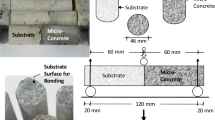ABSTRACT
Latexes including polyvinyl acetate (PVA) and styrene-butadiene rubber (SBR) are widely used to improve adhesion and bond properties of cementitious-based repair materials. The main objective of this paper is to evaluate the effect of such polymers on stability of highly flowable self-consolidating concrete (SCC) during placement and until onset of hardening. Also, the bond properties to existing concrete substrate and steel bars are investigated. Two series of mixtures prepared with relatively low to high water-to-binder ratio and incorporating 5–15 % polymers were tested. Special emphasis was placed to highlight the altered stability responses including flowability, viscosity, passing ability, and segregation resistance with respect to the European Guidelines for SCC. Remarkable improvements in the concrete-bar bond stresses were noticed with PVA and SBR additions. This was attributed to improved concrete elasticity and tensile splitting strength that increased contribution of material bearing strength around the steel bars.











Similar content being viewed by others
References
Final report of RILEM TC 188-CSC “Casting of self compacting concrete,” RILEM Technical Committee, Materials and Structures 2006, 39:937–954
Khayat KH, Assaad J, Daczko J (2004) Comparison of field-oriented test methods to assess dynamic stability of self-consolidating concrete. ACI Mater J 101(2):168–176
Assaad J, Khayat KH, Daczko J (2004) Evaluation of static stability of self-consolidating concrete. ACI Mater J 101(3):168–176
Assaad J, Khayat KH (2006) Effect of viscosity-enhancing admixtures on formwork pressure and thixotropy of self-consolidating concrete. ACI Mater J 103(4):280–287
Ohama Y (1995) Handbook of polymer-modified concrete and mortars. Nihon University, Japan, p 245
Steward PA, Hearn J, Wilkinson MC (2000) An overview of polymer latex film formation and properties. Adv. Colloid Interface Sci 86:195–267
Betioli AM, Gleize PJP, John VM, Pileggi RG (2012) Effect of EVA on the fresh properties of cement paste. Cement Concr Compos 34:255–260
Silva DA, Monteiro PJM (2002) Hydration evolution of C3S-EVA composites analyzed by soft X-rays microscopy. Cement Concr Res 35:351–357
Allan ML (1997) Rheology of latex-modified grouts. Cement Concr Res 27(12):1875–1884
Ribeiro MSS, Goncalves AF, Branco FAB (2008) Styrene-butadiene polymer action on compressive and tensile strengths of cement mortars. Mater Struct 41:1263–1273
Gomes CEM, Ferreira OP, Fernandes MR (2005) Influence of vinyl acetate–versatic vinyl ester copolymer on the microstructural characteristics of cement pastes. Mater Res 8(1):51–56
Chen PW, Fu X, Chung DDL (1997) Microstructural and mechanical effects of latex, methylcellulose, and silica fume on carbon fiber reinforced cement. ACI Mater J 94(2):147–155
Walters DG (1990) Comparison of latex-modified Portland cement mortars. ACI Mater J 87(4):371–377
Nakayama M, Beaudoin JJ (1987) Bond strength development between latex-modified cement paste and steel. Cement Concr Res 17(4):562–572
Aliabdo AAE, Abd-Elmoaty AEM (2012) Experimental investigation on the properties of polymer modified SCC. Constr Build Mater 34:584–592
EPG The European guidelines for self-compacting concrete specification production and use. http://www.efnarc.org/pdf/SCCGuidelinesMay2005.pdf. May 2005
Metelli G, Plizzari G (2014) Influence of the relative rib area on bond behavior. Mag Concr Res 66(6):277–294
ASTM C231/C231M-14 Standard test method for air content of freshly mixed concrete by the pressure method. West Conshohocken
ASTM C232-14 Standard test method for bleeding of concrete. West Conshohocken
ASTM C403 Standard test method for time of setting for concrete mixtures by penetration resistance. West Conshohocken
Legrand C (1971) Contribution to Study of the Rheology of Fresh Concrete (in French), Ph.D. Thesis, Université Paul Sabatier, Toulouse, France pp 150
Assaad J, Khayat KH (2004) Assessment of thixotropy of self-consolidating concrete and concrete-equivalent-mortar—effect of binder composition and content. ACI Mater J 101(5):400–408
Assaad J, Harb J, Maalouf Y (2016) Effect of vane configuration on yield stress measurements of cement pastes. J Non Newton Fluid Mech 230:31–42
Assaad J (2015) Correlating water extraction to viscosity variations of injection grouts. Constr Build Mater 77:74–82
Tattersall GH, Banfill PF (1983) The rheology of fresh concrete. Pitman, Advanced Publishing Program, London
ASTM C39/C39M-05 Standard test method for compressive strength of cylindrical concrete specimens. West Conshohocken
ASTM C496/C496M-04 Standard test method for splitting tensile strength of cylindrical concrete specimens. West Conshohocken
ASTM C469/C469M-14 Standard test method for static modulus of elasticity and Poisson’s ratio of concrete in compression. West Conshohocken
BS EN 1542:1999 Products and systems for the protection and repair of concrete structures. Test methods. Measurement of bond strength by pull-of
Bonaldo E, Barros J, Lourenco P (2005) Bond characterization between concrete substrate and repairing SFRC using pull-off testing. Int J Adhes Adhes 25:463–474
Issa C, Assaad JJ (2014) Bond of tension bars in underwater concrete – Effect of bar diameter and cover. Mater Struct 48(11):3457–3471
ASTM A944-14 Standard test method for comparing bond strength of steel reinforcing bars to concrete using beam-end specimens. West Conshohocken
Mikanovic N, Jolicoeur C, Page M (2006) Influence of surfactant chemical admixtures on the stability and rheological properties of calcium carbonate and cement pastes. ACI Spec Publ 239:321–344
Ray I, Gupta AP (1994) Effect of latex and superplasticizer on Portland cement mortar in the fresh state. Cement Concr Compos 16:309–316
Roussel N, Nguyen TLH, Yazoghli O, Coussot P (2009) Passing ability of fresh concrete: a probabilistic approach. Cement Concr Res 39:227–232
Wang R, Wang PM, Yao LJ (2012) Effect of redispersible vinyl acetate and versatate copolymer powder on flexibility of cement mortar. Constr Build Mater 27:259–262
Liu X, Wang X (2003) A strain-softening model for steel–concrete bond. Cement Concr Res 33:1669–1673
Acknowledgments
This project was funded by the School of Engineering Research Council of the Lebanese American University (LAU), Byblos, Lebanon. The authors wish to acknowledge the experimental support provided by Finders Technical Services, Amchit, as well as Laboratory of the Civil Engineering Department at LAU including the contributions of undergraduate research assistants Hratch Agopian and Yorguo El-Hachem.
Author information
Authors and Affiliations
Corresponding author
Rights and permissions
About this article
Cite this article
Issa, C.A., Assaad, J.J. Stability and bond properties of polymer-modified self-consolidating concrete for repair applications. Mater Struct 50, 28 (2017). https://doi.org/10.1617/s11527-016-0921-6
Received:
Accepted:
Published:
DOI: https://doi.org/10.1617/s11527-016-0921-6




